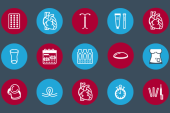Hormonal Birth Control, NSAID Use Together Linked to VTE
Though the absolute risk is low, clinicians can advise their female patients on ways to avoid what might be additive risks.

Women taking certain types of hormonal contraceptives may be more likely to develop venous thromboembolism (VTE) if they’re also taking a nonsteroidal anti-inflammatory drug (NSAID), observational data from Denmark suggest.
In that high-risk category are the combined estrogen/progestin patch, vaginal ring, and tablets with 50 μg ethinyl estradiol, the antiandrogen cyproterone, or the progestins desogestrel, gestodene, or drospirenone. For women taking one of these drugs together with an NSAID, the likelihood of VTE was greater than those who combined an NSAID with either progestin-only formulations or no hormonal contraception.
“Use of birth control formulations containing estrogen (combined hormonal contraception) is an acknowledged risk factor for venous thromboembolism,” lead author Amani Meaidi, MD, PhD (Rigshospitalet, University of Copenhagen, Denmark), told TCTMD. Additionally, NSAIDs—a category that includes ibuprofen, diclofenac, and naproxen, and COX-2 inhibitors—are known to increase the risk of thrombosis by promoting platelet aggregation that can help activate the body’s coagulation system.
As she and her colleagues note in their paper, published recently in the BMJ, the issue of how the two drug types might overlap to affect VTE risk is relevant given their wide use by women around the world.
“NSAID use is likely to be the most common co-medication to hormonal contraception use—still, no study has looked at the effect of concomitant use of hormonal contraception and NSAID on venous thromboembolic risk,” Meaidi wrote in an email.
“There are still important gaps in our knowledge on the cardiovascular risk of hormonal contraceptives,” she said. The extent of these gaps “is surprising considering the massive amount of daily users being exposed to these drugs. I think that the medical science [community] sometimes forgets that hormonal contraceptives first and foremost are pharmaceuticals—before being all the positive things that we [attribute] to them.”
I think that the medical science [community] sometimes forgets that hormonal contraceptives first and foremost are pharmaceuticals. Amani Meaidi
To dig deeper, the researchers turned to data from Denmark’s national registries to track VTE events among 2 million women ages 15 to 49 between 1996 and 2017. They have medical histories involving prior thrombotic events, cancer, thrombophilia, hysterectomy, bilateral oophorectomy, sterilization, or infertility treatment.
Hormonal contraceptives were divided by their expected risk based on prior studies. In addition to the aforementioned high-risk category, the researchers considered medium-risk products (all other combined oral contraceptives and medroxyprogesterone injection) and low/no risk methods (progestin-only tablets, implants, and hormone intrauterine devices).
Around a quarter of the women took NSAIDs, most often ibuprofen, while on hormonal birth control.
Over 21 million person-years, 8,710 of these women experienced a VTE, with 2.6% dying within 30 days of their event. Use of NSAIDs, when adjusted for confounders, was associated with higher VTE risk in women not on hormonal contraceptives, with an incidence rate ratio (IRR) of 7.2, as well as those on hormonal contraceptives considered to carry high, medium, and low/no risk, who had IRRs of 11.0, 7.9, and 4.5, respectively.
For every week of NSAID use, around four women out of 100,000 would develop VTE, the researchers estimated. Around two women out of 100,000 would do so for every week of high-risk hormonal contraceptive use, Meaidi explained. But for women who combined both drugs simultaneously, 23 out of 100,000 would have a VTE event with each week of use.
“This potentially suggests a synergistic drug interaction between these two drug classes,” she said.
For medium- and low/no-risk hormonal contraceptives on top of NSAIDs, there were an extra 11 and three VTEs, respectively, per 100,000 women per week of use.
Diclofenac in particular stood out as risky. When taken alone, around seven women per 100,000 weekly would develop VTE, as compared with three for ibuprofen and three for naproxen. When diclofenac was taken on top of a high-risk contraceptive, there were 28 added events per 100,000 women weekly, as compared with 25 for ibuprofen and 13 for naproxen.
Absolute Risk of 0.02% or Less
“Despite the high incidence rate ratios, the absolute risk of venous thromboembolic event in the first week after NSAID purchase remained low”—at 0.02%—“even in users of high risk hormonal contraception,” the investigators note.
Still, this issue is worthy of clinicians’ attention, said Meaidi, given how common the two medications are used and the severity of VTE.
To reduce the risk of developing VTE, she recommended that women—irrespective of whether they’re taking NSAIDS—switch from high-risk, combined-hormonal contraceptives to medium- or low/no-risk varieties. For pain relief, women can consider NSAID alternatives or nonpharmacological therapy, Meaidi added, and if NSAIDs are necessary, diclofenac should be avoided as it carries the highest CV risk.
Morten Schmidt, MD, PhD (Aarhus University Hospital, Denmark), in an editorial, agrees that the apparent synergism between NSAIDs and contraceptives has important ramifications for public health.
“Healthcare authorities and regulators should include these findings in their safety assessment of available over-the-counter diclofenac, and women using hormonal contraception and their clinicians should consider alternatives to NSAIDs for analgesia,” he suggests. “If treatment with NSAIDs is needed, agents other than diclofenac seem preferable, along with lower-risk hormonal contraceptives such as progestin-only tablets, implants, or intrauterine devices.”
Now researchers should replicate their study’s results in other populations and countries, said Meaidi. “Basic research should aim to investigate the potential mechanism of the interaction between the two drug classes.”
Caitlin E. Cox is News Editor of TCTMD and Associate Director, Editorial Content at the Cardiovascular Research Foundation. She produces the…
Read Full BioSources
Meaidi A, Mascolo A, Sessa M, et al. Venous thromboembolism with use of hormonal contraception and non-steroidal anti-inflammatory drugs: nationwide cohort study. BMJ. 2023;382:e074450.
Schmidt M. NSAIDs, hormonal contraception, and venous thromboembolism: a harmful drug interaction that deserves more attention. BMJ. 2023;382:p1990.
Disclosures
- Meaidi reports support from the Danish Heart Foundation.
- Schmidt reports no relevant conflicts of interest.





Comments